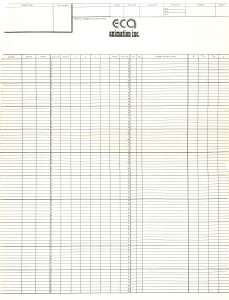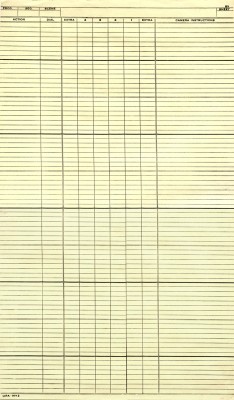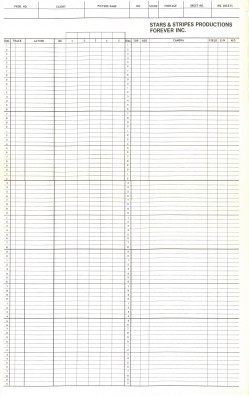Daily post 27 Jun 2009 08:16 am
Return of the Dope Sheets
 - Back in March, I posted some thoughts about exposure sheets and the seeming loss of this tool in animation production. I posted a letter from Kayvon Darabi-Fard in England and tried to respond with some information about the X-sheets and their purpose. The post brought a lot of attention and many comments, and I was pleased with myself for writing about what was becoming a disappearing artifact in animation production.
- Back in March, I posted some thoughts about exposure sheets and the seeming loss of this tool in animation production. I posted a letter from Kayvon Darabi-Fard in England and tried to respond with some information about the X-sheets and their purpose. The post brought a lot of attention and many comments, and I was pleased with myself for writing about what was becoming a disappearing artifact in animation production.
Then this weekend I’d received another letter from Kayvon:
- After your initial post, my lecturer began reminiscing with the dope sheet’s he’d experienced during his time at the Don Bluth Studios in Ireland. Soon after, he then ran an extended class for the first year students of the degree to re-establish and emphasize the ________ECA Prods had probably the
importance of the dope sheet, even in such an _________biggest sheets I’ve seen.
educative environment. ______________________ECA was George Cannata’s company.
So under the over head projector he went,
going from keys, to timing charts, to a fully doped and annotated X-sheet, complimented by a lifting exercise!
Contrary to a tutors reaction to the letter I sent to you;- “You cannot ‘make’ a student use a dope sheet.”
Only now our course leader insists that the Dope sheet is mandatory within the production process’ expected of us as directors during our final year before graduating.
Needless to say, my ego’s gone our of whack with such a pleasant letter to receive. It’s great to see that some small tool of our industry is being taught even to this small sample. I’m delighted, naturally, to have had a small part in it.


exposure sheets from:
(L) UPA NY in the 50′s
(No dial numbers! Extra work for the cameraman)
(R) Stars & Stripes Productions Forever Inc.
a high profile company headed by Vincent Cafferelli in the 60-70′s.

on 27 Jun 2009 at 9:17 am 1.Pierre said …
The traditional exposure sheet isn’t entirely dead if you are using a digital animation set-up. DigiCel’s FlipBook uses a tradtional exposure sheet paradigm to time out your animation drawings. It’s an awesome little program. Almost all programs use a horizontal timeline paradigm but FlipBook uses a horizontal one. This is probably the reason that many traditional animators find FlipBook to be so easy to come to grips with.
Having said this, it’s true that nothing really replaces having a physical piece of paper in front of you to work out all the issues before plunging ahead on your final product. It’s very nice to see this teacher requiring its use. It certainly can give students a real appreciation for planning their animation projects.
on 27 Jun 2009 at 9:19 am 2.Pierre said …
er…I meant to say that FlipBook uses a very traditional vertical exposure sheet paradigm while other programs use a horizontal timeline. Sheesh…it wouldn’t hurt me to proof read my work before hitting send!
on 27 Jun 2009 at 10:32 am 3.John Celestri said …
Not using an exposure sheet to work out your animation timing is like a classical musical composer of orchestral pieces saying, “I don’t need to write down my notes…I just play my instruments until they all sound right together!”
on 27 Jun 2009 at 4:21 pm 4.Elliot Cowan said …
I am sure there is a place in this world for the dope sheet (I don’t have a strong opinion about the use or non use of them).
I’m not sure those of us who are individual operators, compositing digitally have a much need for one.
on 27 Jun 2009 at 6:02 pm 5.Will Finn said …
I don’t get to do much animation any more but my brain is still formatted for the old paper x-sheet. I got a flash file to work with a while back and I could not get my head around it until i transcribed the track to the traditional x-sheet. (I had the same problem with driving–I learned on a stick shift and it took me an embarrassingly long time to get used to an automatic.)
The x-sheet gave me a way to preconceive time (in seconds, frames, feet and half-feet) and space (in levels) so that I already knew a great deal about what assets I would need to draw and break up, well ahead of actually making the drawings. It’s so ingrained that I take it for granted.
It’s probably all a matter of what people are familiar with.
on 27 Jun 2009 at 8:30 pm 6.Patrice said …
I am currently a student in a traditional animation program and I’m glad to say our teachers have strong feelings about the importance of dope sheets. To an extent where we are even graded on them, if they are not filled within to their requirements we lose marks.
Since our first year we have been explained their importance and not without good reason. Everytime I properly filled my dope sheets and planned my animation using all the tradional techniques, the result brought me my best animation.
I’ve learned that when filled out, timed, planned and properly organized it allows you to see your animation even before you start flipping your drawings. I have no doubt dope sheets will stay with me even if studios today don’t enforce animators to use them as much.
on 27 Jun 2009 at 10:20 pm 7.Michael said …
One other thing exposure sheets offer. They give you an excellent and easy chance to plan the rhythm of the scene. This isn’t easy to do when you’re doing it digitally, but you can see the bigger picture from exposure sheets, can mark out the cutting pattern, and plan a beat. The director can do this as easily with X sheets as he can with a workbook.
on 18 Jul 2009 at 10:15 pm 8.Steve Brown said …
Dear Michael,
I just wanted to mention your previous post about bar sheets. It seems like x-sheets and bar sheets are really complementary for mapping out the big picture and the fine detail.
on 23 Sep 2009 at 1:38 pm 9.:: smo :: said …
thank you so much for this series of posts! it’s been fantastic!
as someone who moved to nyc in 2006 to start finding animation work virtually everything i’ve done has been in a computer, half of it hasn’t even entailed drawing, and none of it [unless i did it of my own accord] has used x-sheets. it’s maddening.
i grew up wanting to be an animator, studying the films of the 1930s and 40s setting up in my head a very specific way studios work…and getting here sixty years of animation history later it’s nothing like that at all. so i guess all we can do is try and change it from the inside and get planning like this to come back!
i feel like it’s really easy to get rusty and lazy in the current climate. i was shown x sheets in college even but never explicitly trained on them, and i’ve been trying to fill in the blanks to get things right.
i have a few [i feel slightly ignorant] questions on filling out the sheets if you have a moment to humor me:
i’m familiar with what goes in each column, dialogue, action, fades, camera/field moves etc…
but when it comes right down to the numbering of the frames and how they correspond with the actual drawings, i’ve found some discrepancies.
in eric goldberg’s new[ish] book he says to label the sheets on twos all the way down before you start drawing. but i was under the impression that you were supposed to write down keys, etc on the sheet as you plan them, filling in the other drawings on the sheet as you get to them? so that someone can look at the sheet and see what’s actually been done?
or is that just all left up to the charts and the x-sheet is totally numbered before you get to drawing.
richard williams doesn’t seem to lay this out either, just the best ways of numbering and it’s left me a bit confused.
i guess in summation [assuming all the action etc is filled in on the sheet], do you fill the numbers on the x-sheet in as you are drawing or do you fill it all out beforehand?
is there any interaction with the sheet in the animation process or is it more of a reference?
any help here would be fantastic, and no worries if you’re too busy to get to it, i feel kind of silly for having such a fundamental question
thanks!
on 23 Sep 2009 at 2:12 pm 10.Michael said …
I wouldn’t know how to fill out a sheet as you describe Eric suggesting you do. Things don’t just go ahead endlessly on twos. There are holds, there are ones and there are threes. I feel as though you have to let the scene breathe.
I can only imagine filing it out as you go along interacting with the sheets while you’re drawing. Things are constantly in flux for someone like me who allows the animation acting to grow as it goes. Only the timing of the soundtrack should rule your animation.
Others like to preplan the scene to death and thumbnail everything out sticking to those plans in a hardened way. I don’t. I’m more of a straight-ahead type animator (even though I don’t quite work that way).
In short, it’s completely up to the animator. You can let it grow as you like, interact with the sheets as you like, or let the sheets dominate your scenes. There’s no rule of thumb.